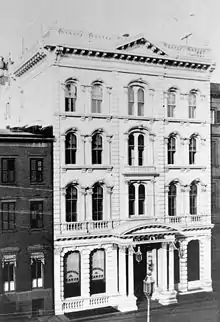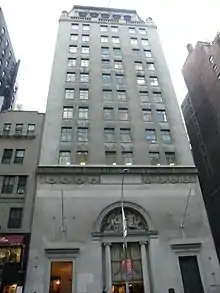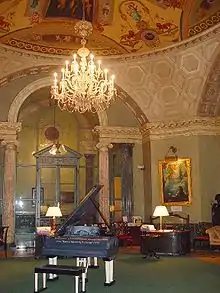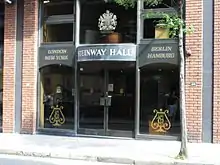Steinway Hall
Steinway Hall (German: Steinway-Haus) is the name of buildings housing concert halls, showrooms and sales departments for Steinway & Sons pianos. The first Steinway Hall was opened in 1866 in New York City.[1] Today, Steinway Halls and Steinway-Häuser are located in cities such as New York City, London, Berlin, and Vienna.

A related concept by Steinway is "Steinway Piano Galleries". The Steinway Piano Galleries have all the same features as Steinway Halls, but are smaller.
New York City

14th Street (1864–1925)
In 1864, William Steinway built elegant showrooms housing over 100 Steinway & Sons pianos at 71–73 East 14th Street, between University Place and Fifth Avenue in Manhattan.[2] During the next two years, demand for Steinway pianos had increased dramatically. Construction of the first Steinway Hall was pushed by the need for expansion, increased promotion, and better presentation of pianos and music culture through regular live performances.
William Steinway carried planning and construction of the first Steinway Hall with the full support and cooperation from the City of New York. The concert hall was designed with 2,000 seats, and had a concert stage for a full 100-piece symphony orchestra. The concert hall was built in 1866 behind the showrooms on 14th Street in Manhattan and was one of the first concert halls for wider audiences in New York City.[2] Four days after the Academy of Music on 14th Street a few blocks away burned down to the ground, on May 22, 1866, William Steinway laid the first stone of the Steinway Hall building.[3] The hall opened on October 31, 1866.[4] Its four floors had enough space to fit in a showroom for more than 100 pianos, the concert hall and rooms for piano lessons. The hall and the other rooms were illuminated with over 700 gaslights. The ground floor was occupied by the showroom and the office. The first floor there was taken by the concert hall. With 2,500 seats at that time, it was one of the biggest halls in the city of New York, becoming soon one of the cultural centers of the United States.[5] One critic wrote, "no larger auditorium—before or since—has ever been built by a musical instrument manufacturer."[3] Another observer, Moses King, called Steinway Hall "the cradle of classical music in this country".[4]
The first Steinway Hall was also the home for the New York Philharmonic for 25 years, from 1866 to 1891, when Carnegie Hall opened in Midtown Manhattan. William Steinway recognized that it would be good for piano sales, if famous piano artists have a place to play on Steinway pianos, and also take a Steinway piano on a concert tour. In 1872, Steinway & Sons organised an unprecedented concert tour of 215 performances in 239 days for the Russian virtuoso pianist Anton Rubinstein. Rubinstein's legendary concert at the Steinway Hall was sold out with 3000 guests, many of them standing. Cultural highlights included performances of such artists as Fritz Kreisler, Walter Damrosch, Jenny Lind, readings of Charles Dickens and performances of the Boston Symphony Orchestra.
Steinway Hall, as the center of New York's cultural life, attracted more customers to Steinway showrooms. The marketing idea was so successful for Steinway & Sons, that competition forced other piano manufacturers, such as the Aeolian Company and Chickering & Sons to build their own concert halls, the Aeolian Hall and Chickering Hall in New York. Other piano companies also invested in renowned stars tours in the United States, such as Pyotr Ilyich Tchaikovsky, who was invited on a two-month US tour in 1891, by piano maker Wm. Knabe & Co. Around the same time, concert halls were also built in Boston, Chicago, Baltimore, and Philadelphia.
After Carnegie Hall's opening, the piano industry moved uptown to 57th Street, where Carnegie Hall was located. Accordingly, the main auditorium of Steinway Hall on 14th Street was closed, although performances continued to take place in the smaller recital halls. The S. Klein Union Square Realty Corporation bought the Steinway Hall on 14th Street in 1923 and closed it two years later. While the section on 14th Street was immediately demolished, the rear section housing the concert hall remained through the 1980s.[2]
57th Street (1925–2014)


After the closure of the auditorium at 14th Street, Steinway & Sons began looking for new sites near Carnegie Hall.[2] By July 1916, the company had found a site at 109–113 West 57th Street, between Sixth and Seventh Avenues with a lot reaching back to 58th Street.[6][7] William K. Benedict and Marvin & Davis designed a 10-story building for the site. However, work was held up because the 1916 Zoning Resolution prohibited non-residential buildings on that section of 58th Street, and because existing residents had filed lawsuits against Steinway & Sons, which were settled by July 1920. Steinway & Sons acquired eight lots on 57th and 58th Streets from 1920 to 1924, and Warren and Wetmore designed a 16-story building, for which plans were filed in July 1923. The new Steinway Hall was built from June 1924 to April 1925.[8] The official opening night was on October 27, 1925, with a performance by Willem Mengelberg and 35 musicians from the New York Philharmonic , broadcast over radio.[9][10]
The building cost $3 million,[8][11] representing about a quarter of Steinway & Sons' total assets at the time.[8][12] The building was a speculative development for Steinway & Sons, but was not particularly successful, with a rate of return of only 2%.[13][14][15] Steinway & Sons used the five lowest floors and rented out the upper floors. The basement housed storage, shipping, and a grand-piano testing area; the first story, a reception room and salesroom; the second story, salesrooms; the third floor, executive offices; and the fourth and fifth stories, music studios. The "piano bank" in the basement had over 300 pianos, valued at over $15 million.[10] A New Yorker article in 2001 said, "almost every twentieth-century virtuoso has passed through" the first-floor reception room while headed to the Concert and Artists Department in the basement.[10][16]
Among the notable performances at the 57th Street building was the 1928 duo piano recital by Vladimir Horowitz and Sergei Rachmaninoff.[10] In 1997, Steinway Artist Jeffrey Biegel performed the first classical music recital transmitted live over the internet with audio and video, sent from Steinway Hall in New York City.[17]
Steinway Hall and its land were sold to the Manhattan Life Insurance Company in 1958.[18] After the sale, Steinway & Sons continued to lease space there, while Manhattan Life had its headquarters at Steinway Hall until 2001. Steinway Hall was acquired by 111 West 57th Street Associates in 1980.[13] Throughout the years, the building's tenants also included publications such as Musical America, Architectural Forum, and The Economist, as well as CBS broadcasting studios.[19] In May 1999, Steinway bought back the building for approximately $62 million, and leased the land for 99 years from the former owner, who chose to retain ownership of the land.[20] The New York City Landmarks Preservation Commission (LPC) designated Steinway Hall as a New York City landmark in November 2001.[21][22] By June 2013, Steinway & Sons sold the building's leasehold interest to a partnership led by JDS Development Group for $46.3 million.[23] The Steinway Hall on 57th Street would be incorporated into a residential development at 111 West 57th Street, which started construction in 2015.[24]
Sixth Avenue (2014–present)
After selling the Steinway Hall on West 57th Street, Steinway moved out of the building in the end of 2014.[25] In 2016, a new Steinway Hall opened at 1133 Sixth Avenue and 43rd Street,[26] next to The Town Hall, a Steinway venue.[27]
London

The Steinway Hall in London was opened in 1875 and became the first Steinway Hall in Europe. It has showrooms as well as several practice rooms available for musicians of all ages. The "piano bank" at London's Steinway Hall consists mostly of Hamburg Steinways, and also has a few New York Steinways D-274, in order to satisfy a greater range of performing artists.
Berlin
The Steinway-Haus in Berlin is one of boutique centers of music and entertainment, it has its own place in the cultural life of the German capital. Since its opening in 1909, the Steinway-Haus in Berlin has been through many dramatic events of history, it was re-opened in 1948 in the ex-house of the pianist Josef Hofmann in the Hardenbergstraße No. 9. Today Steinway-Haus in Berlin has a miniature concert hall, several showrooms, and practice rooms available for children as well as adults to study music. Over 80 Steinway, Boston and Essex pianos are housed in the 3-story building. The Steinway-Haus has a "piano bank" of Hamburg Steinway pianos maintained and available for use in concerts and studio recordings by guests as well as by local entertainers.
Hamburg
In 1953, the Steinway-Haus was opened on the Colonnaden street in Hamburg. In 2003, the 50th anniversary of Steinway-Haus Hamburg was marked by a series of concerts of classical and popular music performed by numerous guest stars as well as by local musicians. Today Steinway-Haus in Hamburg has a concert hall, several showrooms, and practice rooms available for children as well as adults to study music. Over 100 Steinway, Boston and Essex pianos are housed in the 5-story building. The Steinway-Haus has a "piano bank" of Hamburg Steinway pianos maintained and available for use in concerts and studio recordings by guests as well as by local entertainers. The 125th anniversary of the Hamburg Steinway factory was marked by a large-scale festival of music, held on April 17, 2005.
Munich
The Steinway-Haus in Munich was acquired in 2000, it was formerly named Pianohaus Lang, which was an old Steinway dealership partner. It is located in the historic part of the city and plays a role in the cultural life of Bavaria and its capital. It has a miniature concert hall, showrooms and practice rooms for students of all ages to study music. The "piano bank" has mainly Hamburg Steinway pianos maintained and available for local entertainers and touring performers.
Vienna
.jpg.webp)
The Steinway-Haus in Vienna on the Ringstraße is one of the boutique Steinway showrooms that caters to entertainers in Austria and Central Europe. Besides the showrooms, the Steinway Haus in Vienna has several practice rooms and music classes open for students of all ages to polish their performing skills. The Steinway concert department has a "piano bank" of Hamburg Steinways. The Steinway-Haus of Vienna has been the main supplier of concert grand pianos to classical venues, as well as other entertainment centers in the capital of Austria.
Chicago
Steinway Hall in Chicago (1896–1970) was a theater, and later cinema, located at 64 E. Van Buren Street, Chicago.[28] It had at least 14 different name changes over the years, opening in 1896 as the Steinway Hall, and closing in the late 1960s as Capri Cinema.
Newer Steinway Halls
Steinway Hall and showrooms opened in Seoul, catering to performers and musicians of the Seoul Philharmonic Orchestra and the Kangnam University, which is also an All-Steinway School. Steinway & Sons' main showroom recently opened in Beijing, where UNICEF Goodwill Ambassador Lang Lang introduced his own branded line of pianos, designed by Steinway & Sons, to the audience of Beijing society and media. The 65th Steinway Children and Youth Competition was recently held in Beijing. Today, additional forms of Steinway & Sons sales venues are located in Shanghai and Tokyo.
References
Citations
- "Steinway & Sons – Steinway & Sons History". steinwayshowrooms.com. Retrieved 28 May 2015.
- Landmarks Preservation Commission 2001, p. 3.
- Fostle, D.W. (1995). The Steinway Saga: An American Dynasty. Scribner. p. 157. ISBN 978-0-684-19318-2.
- King, Moses (1893). Kings Handbook of New York City. King's Handbook of New York City: An Outline History and Description of the American Metropolis ; with Over One Thousand Illustrations. Moses King. p. 563.
- "Heinrich Steinweg" in: Meyers Konversations-Lexikon, vol. 15. Leipzig 1888, p. 280.
- "Steinway & Sons to Move Uptown; Piano Firm Buys West 57th St. Site and Plans to Erect Ten-story Building". The New York Times. 1916-07-04. ISSN 0362-4331. Retrieved 2020-11-10.
- Landmarks Preservation Commission 2001, pp. 3–4.
- Landmarks Preservation Commission 2001, p. 4.
- Patty Fagan, John Graves. "Steinway Hall opening concert (3) – Times review (The New York Times, October 28, 1925)". Retrieved 9 April 2016.
- Landmarks Preservation Commission 2001, p. 5.
- Lieberman 1997, p. 331.
- Fostle 1995, p. 458.
- Landmarks Preservation Commission 2001, p. 7.
- Lieberman 1997, p. 264.
- Fostle 1995, p. 458.
- Stewart, James B. (2001-08-20). "Matchmaker". The New Yorker. Retrieved 2020-11-10.
- Rosenblum, Ira (1997-07-08). "Live Video Is Joining Sound on the Web". The New York Times. ISSN 0362-4331. Retrieved 2020-11-10.
- "Steinway Sells Home on 57th St.; Piano Concern Leases Back Space in Building in Deal With Manhattan Life". The New York Times. 1958-04-22. ISSN 0362-4331. Retrieved 2020-11-10.
- Landmarks Preservation Commission 2001, p. 8.
- "Postings: $62 Million for 57th Street Structure and Lease on Land; Steinway Buys Its Building". The New York Times. May 30, 1999. ISSN 0362-4331. Retrieved November 9, 2020.
- Landmarks Preservation Commission 2001, p. 1.
- Dolkart, Andrew S. & Postal, Matthew A.: Guide to New York City Landmarks; Third Edition: The New York City Landmarks Preservation Commission; John Wiley & Sons, Inc; 2004. p. 126.
- Reuters: Kohlberg to buy grand piano maker Steinway for $438 mln, July 1, 2013
- Fendak, Nikolai (August 8, 2013). "111 West 57th Street to Soar 1,200 Feet". YIMBY. Retrieved August 17, 2015.
- "Steinway Hall's Final Movement Begins Following $131 M. Sale". Commercial Observer. Retrieved 28 May 2015.
- Dangremond, Sam (April 12, 2016). "Take a Tour of the New Steinway Hall". Town & Country. Retrieved April 19, 2016.
- Rent the Hall, The Town Hall (New York City)
- Bryan Krefft. "Capri Cinema". cinematreasures.org. Retrieved May 10, 2012.
Sources
- Fostle, D.W. (1995). The Steinway Saga: An American Dynasty. Scribner. ISBN 978-0-684-19318-2.
- Lieberman, Richard K. (1997). Steinway and Sons. Yale University Press. ISBN 978-0-300-24716-9.
- "Steinway Hall" (PDF). New York City Landmarks Preservation Commission. November 13, 2001.
External links
| Wikimedia Commons has media related to Steinway Halls. |
- Steinway Hall Manhattan New York City (obsolete)
- Steinway Hall New York, history
- Steinway Hall Dallas
- Steinway Hall Fort Worth
- Steinway Hall London
- Steinway Hall Plano
- Steinway Hall Suisse Romande
- Steinway-Haus Berlin
- Steinway-Haus Düsseldorf
- Steinway-Haus Frankfurt
- Steinway-Haus Hamburg
- Steinway-Haus München
- Steinway-Haus Wien